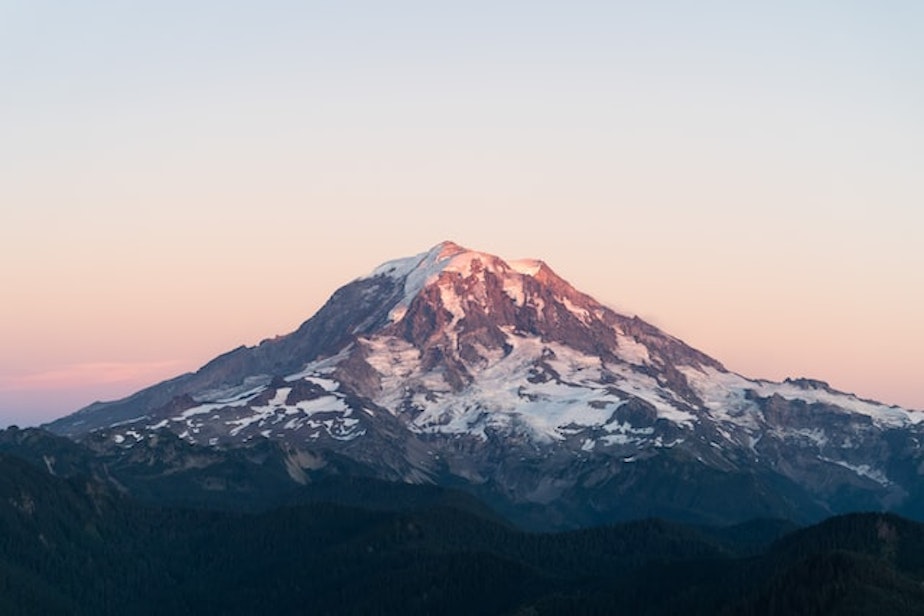How should park officials deal with traffic/visitors on Mount Rainier? Give your feedback

Mount Rainier National Park is the crown jewel of Washington’s wilderness.
With snow-covered peaks, acres of forests, and sprawling subalpine meadows, it’s no wonder about two million people visit the park each year.
The park estimates that about 70% of those visitors come during peak summer months. And a lot of those visitors travel to the park by car.
Park officials say it’s time to get a handle on all that congestion. And they’ve put together four options that the public can weigh in on until Monday.
Soundside host Libby Denkmann talked to Teri Tucker, the planning compliance lead at Mount Rainier National Park, about what the park is experiencing when it comes to crowds and traffic.
During peak wildflower bloom in the summertime, Tucker says visitors can wait in line to enter the park for "hours at a time."
"But on those peak days, folks are oftentimes exceeding the width of the trail and so folks are stepping off the trail we're seeing the loss of some of those subalpine meadow segments as trampling occurs," Tucker said. "And in our short growing season in those very sensitive environments, it can cause some serious damage."
Sponsored
Over the last few years, the park has been collecting input from visitors about how to best address congestion in the park.
In May, they released a Nisqually to Paradise Draft Corridor Management Plan, and opened the public comment period.
The park has laid out four options, or "alternatives":
- No action alternative. Under this plan, the current management of the Nisqually to Paradise Corridor would continue as it exists today. Visitors can keep accessing the park through the use of private vehicles, and parking at Paradise and at Sunrise would continue on a first-come, first-served basis.
- Create a reservation system for the Nisqually to Paradise Corridor. The Nisqually and Stevens Canyon entrance stations would be monitored by a reservation system.
- Create a reservation system for visitors to access Paradise, and create a within-park shuttle system from the Cougar Rock picnic area. With this option, park visitors could still allow visitors without a reservation a chance to visit Paradise.
- Manage access to Paradise and other park destinations with a reservation system. The Paradise parking lot would also be managed through a reservation system during the summer.
Betsy Robblee is the conservation and advocacy director with The Mountaineers, an outdoor recreation, conservation, and education nonprofit based in Seattle.
Sponsored
Robblee estimated that during the month of July, several hundred mountaineers head up to Mount Rainier, usually accessing the park through private vehicles or vans used by The Mountaineers organization.
"Crowding and just increased congestion is definitely an issue that's been reported by our leaders," Robblee said. "[It's] primarily an issue during the peak summer months. People report increased crowding on trails, lack of parking entrance lines. And we manage these issues the best we can just like other recreationists — we arrived early to beat the crowds, carpool as much as possible and select weekday days to go if we can."
The Mountaineers have submitted comments to the National Park Service about their draft plans to address congestion in 2020 and 2021, and they’re planning to submit another comment ahead of Monday’s deadline.
Robblee said the organization is most concerned about a parking reservation system’s potential impact on bringing their members, and underserved communities, to the mountain.
“People that, you know, aren't familiar with public land systems who might not have regularly scheduled time off, who might have challenges, you know, accessing technology to make a reservation," Robblee said. "And we're just really concerned that this will create additional barriers for people who already experienced barriers to the outdoors.”
Sponsored
It remains unclear what solutions the National Park Service will use to address congestion in the park. But to Robblee, this process represents the future of outdoor recreation — spaces that are increasingly threatened by climate change and increased visitation.
She said, whatever the solution is, it will likely be challenging for the public to adjust to new limitations. She said "robust options and advocates" are needed to help keep national parks thriving.
"It's really important for anyone that visits national parks, and other state and federal public lands, to really be an advocate for these places and to advocate for robust funding for the Park Service and other public land managers," Robblee said. "And we really need to urge our elected officials to robustly find these places to provide them with enough staffing and resources, so that people can continue to have great experiences and experience these special places now and into the future."
The public comment period for the draft plan to mitigate Mount Rainier National Park traffic is open until Monday, June 26.
You can submit your feedback on the National Park Service's website.
Sponsored
Listen to the full segment above.





